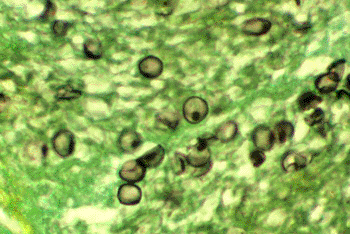Pneumocystis jirovecii Genome Exemplifies Obligate Parasite Infecting only Humans
By LabMedica International staff writers
Posted on 07 Jan 2013
Genomics researchers using a novel in silico selection technique have sequenced the genome of the fungus Pneumocystis jirovecii from a sample obtained from the lung of a single patient.Posted on 07 Jan 2013
Pneumocystis pneumonia (PCP) or pneumocystosis is a form of pneumonia caused by the yeast-like fungus P. jirovecii. It is an opportunistic infection that occurs most frequently in individuals with diminished immune systems such as AIDS victims or organ transplant recipients. The pathogen is specific to humans and has not been shown to infect other animals. Other species of Pneumocystis that parasitize other animals have not been shown to infect humans.

Image: Pneumocystis pneumonia (PCP) or pneumocystosis is a form of pneumonia caused by the fungus Pneumocystis jirovecii (Photo courtesy of the CDC).
Despite having been discovered more than one hundred years ago, P. jirovecii cannot be grown in culture. Since this method for producing a specimen for gene mapping was unavailable, investigators at the University of Lausanne (Switzerland) turned to a single bronchoalveolar lavage-fluid specimen from a patient.
The investigators concentrated the P. jirovecii cells in the specimen using immunoprecipitation and then amplified copies of the fungal DNA by PCR. This mixture of DNA strands - from the fungus, the patient, and other microbes present in the lungs of the patient - was then sequenced using high throughput technologies.
The major challenge facing the investigators was differentiating sequences of fungal DNA from those belonging to the various contaminants. This task was accomplished, however, and results were published in the December 26, 2012, online edition of the journal mBio. These results revealed that the P. jirovecii genome lacked virulence factors and most amino acid biosynthesis enzymes and presented reduced GC (guanine-cytosine) content and size. Together with epidemiological observations, these features suggested that P. jirovecii was an obligate parasite specialized in the colonization of human lungs, which caused disease only in immune-deficient individuals.
"Recognized first among malnourished infants, P. jirovecii pneumonia became a public issue with the advent of the HIV epidemic," said senior author Dr. Philippe Hauser, professor of molecular mycology at the University of Lausanne. "Today, the disease most commonly affects HIV-infected persons who are unaware of their status as well as solid organ transplant recipients and patients with hemato-oncologic or autoimmune diseases. Since the organism cannot be grown in the lab for study, researchers have long made do with studying P. jirovecii's lab-friendly relatives, species that infect animals and plants, in order to explore the secrets of the human disease. It is obviously better to study [P. jirovecii's] genes rather than those of Pneumocystis species from animal models. The genome has both medical and evolutionary interests for the scientific community."
Related Links:
University of Lausanne













